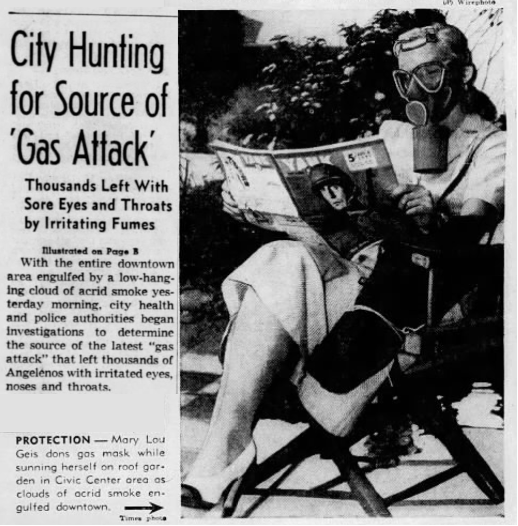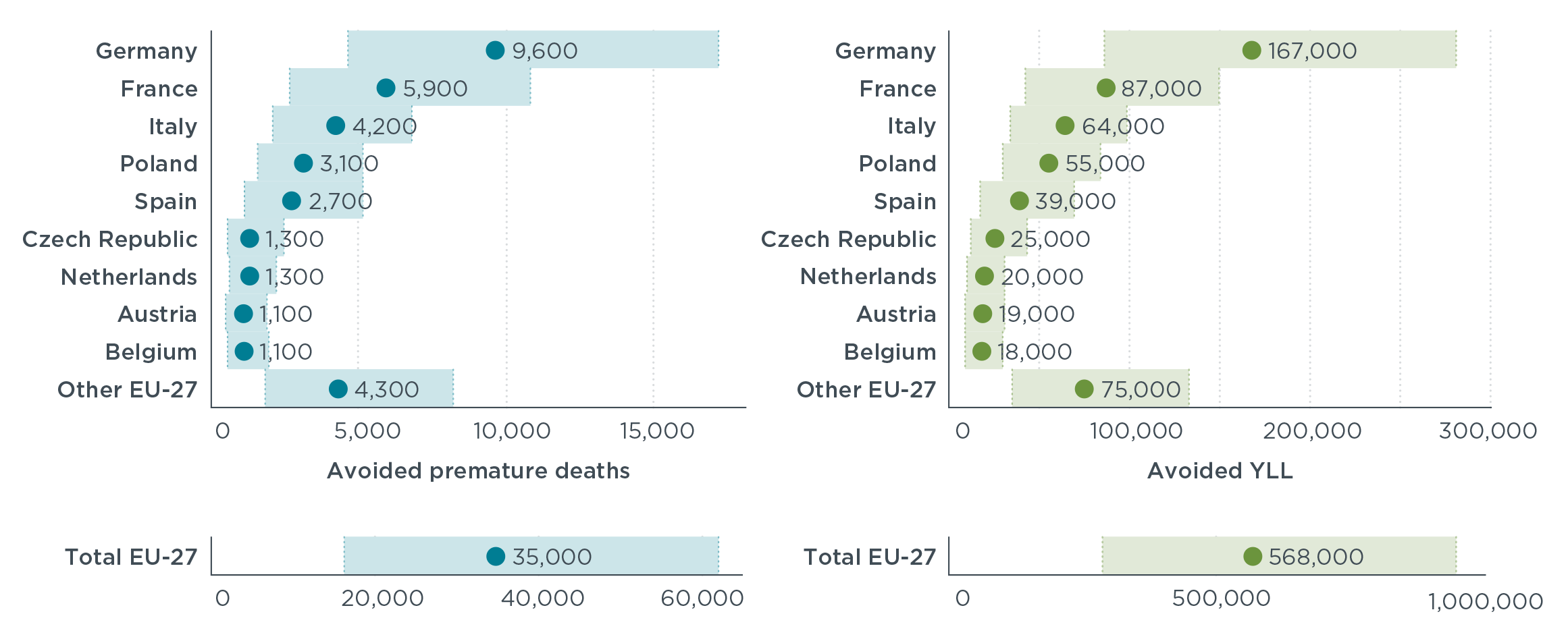Estimated cost of diesel emissions control technology to meet future Euro VII standards
Blog
The ongoing battle for stricter vehicle emission limits in Europe
On July 26, 1943, a great smog descended on the city of Los Angeles. Visibility was seriously impaired, noses began to run, and eyes began to sting. Being in the midst of World War II, the effects were so severe, rumors began to run through the city that the Japanese had just launched a chemical attack. The following day, the alleged chemical attack made front page news on the LA Times, sitting idly alongside news of Mussolini and Hitler. A spokesman from the Health Department was sent in to clear up the confusion, stating that, “’Tain’t tear gas bombs or chemical warfare. It’s just industrial gases.”

However, the severity of these ‘industrial gases’ (or local air pollutants, as they are now more commonly known) was not to be downplayed. One of the main sources was, and very much still is, the beloved automobile. Cars, vans, trucks, and buses that run on fossil fuels emit a range of pollutants that degrade air quality. Inhaling traffic-related pollution can reduce your life expectancy by putting you at an increased risk to heart disease, lung disease, and stroke, just to name a few.
When the link between this toxic concoction of emissions and the Los Angelenos’ beloved car became clear, California passed the world’s first law to clean up vehicles in 1959. This marked the start of regulating the level of emissions spewed from automobiles, which left the automobile industry none too pleased. Lobbyists claimed the standards were impossible to achieve and predicted ruinous costs. Yet, despite these claims, the industry has been able to continue meeting the imposed standards over the past decades while largely continuing to churn out healthy profits, even during a global pandemic.
Half a century on, and the narrative has scarcely changed. Later this year, the European Commission will finalize the next iteration of vehicle emission standards, known as Euro 7 for cars and vans, and Euro VII for trucks and buses, and still the automobile industry is putting up a fight by echoing the arguments of their predecessors—claiming that the proposed standards are unnecessary, infeasible, and costly.
We strongly disagree with each of these points. Moreover, stricter standards are necessary to save lives. In 2018 alone, over 400,000 people in Europe died prematurely as a result of air pollution. The crux of the industry’s argument against more stringent standards lies in the claim that the current vehicle standards are sufficient to lower emissions to a level in line with European air quality limits, so there is no need to put in any more effort. However, there is compelling scientific evidence that continued reductions beyond current limits will further reduce fatalities and other pollutant impacts on health. In other words, the limits set by air quality standards do not guarantee a safe level of exposure.
Moreover, these European limits are not as stringent as the ones set by the World Health Organization and the United States. Nor do the air quality standards include sufficient enforcement provisions, as shown by a recent ruling by the EU’s top court which found that Germany has failed to limit poor levels of air pollution in several regions from as far back as 2010.
To show just how necessary these standards really are, in a recent ICCT paper we looked into what is an achievable level of emissions reduction for Euro 7/VII standards, and what kind of impact they would have on overall air quality and health benefits out to 2050. Here we focus on one pollutant in particular—nitrogen oxide (NOx)—which causes harmful health impacts by itself but, more importantly, also acts as a precursor to fine particulate matter and ozone which are the two leading causes of premature deaths related to air pollution. The transport sector is a big contributor to NOx emissions, responsible for nearly 40% of total NOx emissions in Europe.
In our analysis, we modeled potential Euro 7/VII standards that achieve an 80% reduction in NOx emissions for diesel engines, and 66% for gasoline engines cost-effectively. Our analysis showed there is a big gap in emissions between future standards (Euro 7/VII) and current standards (Euro 6/VI). By 2050, if we simply continue to roll out Euro 6/VI vehicles, NOx emissions will be four times higher than if we were to adopt Euro 7/VII standards. This emissions reduction would prevent more than 35,000 premature deaths in Europe, equivalent to avoiding 568,000 years of life lost, between 2027 and 2050 relative to if we didn’t roll out Euro 7/VII (see figure below). The global impact will be even greater when you consider that lots of countries follow Europe’s lead with these emission standards, including many countries across Asia and South America, as well as most members of the G20.

At this point, you might point out that electric vehicles can provide even cleaner air than Euro 7/VII standards as they don’t produce any NOx emissions. This is certainly true, but there is uncertainty about how quickly electric vehicles will be adopted. From an implementation standpoint, the European Commission is much closer to implementing Euro 7/VII standards than it is to setting CO2 standards or policies that achieve 100% sales of zero-emission vehicles. By implementing an ambitious and attainable Euro 7/VII standard this year, we can lock in the air quality benefits, ensuring that we will save lives. In other words, a Euro 7/VII standard is complementary to, rather than in conflict with, the transition to zero-emission vehicles.
So, despite the automotive industry’s claim, Euro 7/VII standards are necessary from the standpoint that they could lower emissions and avoid tens of thousands of premature deaths. But let’s look at the industry’s other argument—that the technologies required to get there are infeasible and costly.
The emissions control systems required to meet the current emission standards can already convert NOx emissions with more than 99% efficiency under highway driving. However, several technology upgrades are needed to address the higher emissions in urban driving conditions, which will be one of the central elements of the new Euro 7/VII standards.
To achieve these greater emission reductions, vehicles will have to rely on larger catalyst volumes, as well as improved component design and system integration. With the progressive hybridization of vehicle powertrains, other aftertreatment technologies could also become relevant. For example, electric catalyst heating, which has been commercially available since the 1990s but never achieved significant penetration due to the lack of regulatory pull, is now considered a promising option to comply with the new standards. On the engine side, several technologies that are already widely used in cars and vans can be employed, including cylinder deactivation, exhaust gas recirculation cooler bypass, and 48-volt systems. As an added bonus, many of these technologies can simultaneously reduce CO2 emissions, unlike past NOx controls.
So, the technologies required to achieve Euro 7/VII are readily available. But even more so than that, the costs to comply with the new standards are expected to be relatively low. In a recent ICCT working paper, we estimated that complying with Euro VII would only result in a 2%–5% increase in the price of heavy diesel trucks.
For entry-level gasoline cars, complying with the Euro 7 standard will likely not require much technology development. For example, a small size electric catalyst heater would significantly improve cold-start emissions and would amount to only about €150 in additional cost, equivalent to 0.3% – 0.5% of the average retail price of a car in the EU-27. For diesel cars and vans, it is expected that the CO2 regulations will drive widespread adoption of 48V systems. Thus, it would cost about an additional €600 to comply with Euro 7 standards, which equates to around 1%–2% of the average retail price. These marginal increases in vehicle costs in effect shift the societal cost bourn by the public toward the production costs of vehicles.
In short, Euro 7/VII standards will prevent tens of thousands of premature deaths equivalent to avoiding hundreds of thousands of years of life lost, by employing technologies that already exist, and which will increase the cost of new cars by less than 2% and the cost of new trucks by less than 5%. Yet the decades-long battle rages on between cleaner air and the automobile industry’s claims of infeasibility. This chapter of the battle may not be as dramatic as the fear of World War II chemical attacks, such as what the Los Angelenos of 1943 feared, but lives are still very much at stake.
